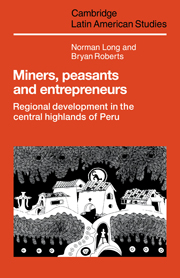Book contents
- Frontmatter
- Contents
- List of tables
- List of figures
- List of maps
- Preface
- 1 Regional development in an export economy
- 2 The development of a regional economy in the central highlands
- 3 The Mining Corporation and regional development
- 4 Class relations, local economies and large-scale mining
- 5 Highland puna communities and the impact of the mining economy
- 6 Migration and social differentiation amongst Mantaro valley peasants
- 7 Industrialization and the emergence of an informal regional economy
- 8 The village economy, agricultural development and contemporary patterns of social differentiation
- 9 Regional commitment among central highlands migrants in Lima
- 10 Confederations of households: extended domestic enterprises in city and country
- 11 Regional development in peripheral economies
- Notes
- Bibliography
- Index
- Titles in the series
3 - The Mining Corporation and regional development
Published online by Cambridge University Press: 07 May 2010
- Frontmatter
- Contents
- List of tables
- List of figures
- List of maps
- Preface
- 1 Regional development in an export economy
- 2 The development of a regional economy in the central highlands
- 3 The Mining Corporation and regional development
- 4 Class relations, local economies and large-scale mining
- 5 Highland puna communities and the impact of the mining economy
- 6 Migration and social differentiation amongst Mantaro valley peasants
- 7 Industrialization and the emergence of an informal regional economy
- 8 The village economy, agricultural development and contemporary patterns of social differentiation
- 9 Regional commitment among central highlands migrants in Lima
- 10 Confederations of households: extended domestic enterprises in city and country
- 11 Regional development in peripheral economies
- Notes
- Bibliography
- Index
- Titles in the series
Summary
From the early twentieth century, the central highlands became an integral part of Peru's expanding export economy, being the principal location of the mining industry and an important contributor to the development of wool production and, through the supply of seasonal labour, to the operation of the coastal cotton estates. The impact of the export sector on the economy of the central highlands was, as we shall show, substantial both in terms of the wages spent locally and in terms of the linkages that developed between the export sector, agriculture, commerce, transport and local manufacturing industry. These linkages did not result, however, in a significant regional accumulation of capital in agriculture and industry. Such an accumulation, in terms of industrial plant and infrastructure, of the consolidation and modernization of farms and of the linkages between these sectors, could have provided the basis for a pattern of self-sustained regional development. Why such a development failed to materialize is the focus of this chapter.
At the beginning of the twentieth century the central highlands region had the resources needed for growth. The largest deposits of silver, copper, lead, zinc and coal known in Peru were located in the Department of Junín. Timber was available from the tropical lowlands, while there was extensive arable and livestock farming in the valleys and surrounding puna. Junín was, at this time, the single most important national source of barley, potatoes and wheat and, after Puno, was one of the major national centres of wool production.
- Type
- Chapter
- Information
- Miners, Peasants and EntrepreneursRegional Development in the Central Highlands of Peru, pp. 44 - 69Publisher: Cambridge University PressPrint publication year: 1984

